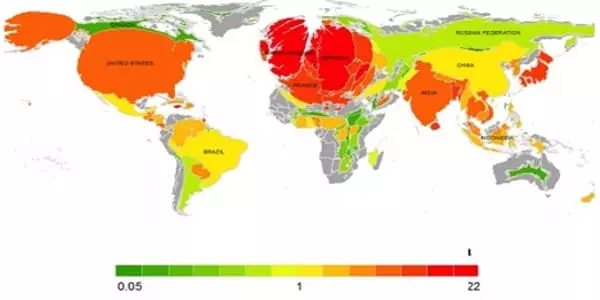We are putting future generations at risk of incurring a massive carbon debt as atmospheric CO2 concentrations continue to rise. Researchers are calling for immediate action to establish carbon debt responsibility by implementing carbon removal obligations, such as during the upcoming revision of the EU Emissions Trading Scheme.
Governments have collectively pledged to slow global warming over the last several decades through treaties such as the Kyoto Protocol and the Paris Agreement. Despite the fact that these agreements have been ratified by a large number of countries, CO2 concentrations in the atmosphere continue to rise. At the current rate, we are well on our way to depleting the remaining CO2 emissions in time to limit temperature rise to 1.5°C within the next ten years. If this so-called “carbon budget” is depleted before global net-zero emissions are achieved, we will be required to remove one tonne of CO2 from the atmosphere later in the century for every additional tonne of CO2 emitted after this point. In other words, if we continue on our current path, which is highly likely, we will accumulate a carbon debt.
According to the authors of a new study published in Nature, a growing number of countries’ net-zero pledges already assume that a significant amount of carbon debt will need to be compensated for by net negative emissions in the long run. Idealized global scenarios from the Intergovernmental Panel on Climate Change (IPCCSpecial)’s Report on 1.5°C Warming, for example, suggest that carbon debt could amount to the equivalent of 2 to 18 years of pre-COVID emissions. This figure is likely to rise if we do not reduce CO2 emissions by roughly half by 2030, or if significant Earth system feedbacks, such as additional emissions from permafrost melting, occur.
Carbon removal obligations completely change how we see CO2 removals: from magical tools to enable a 30-year long period of the grand atmospheric restoration project, to a technology option that is developed and tested today and flexibly and incrementally scaled throughout the twenty-first century and possibly beyond.
Fabian Wagner
“With its recently adopted Climate Law, the European Union has decided not only to achieve net-zero greenhouse gas emissions by 2050, but also to go net negative thereafter, potentially assisting in reducing global carbon budget overshoot. However, this is only a declaration so far, as no serious discussion of instruments to establish long-term responsibility for large-scale carbon dioxide removal has occurred, both in the political and academic debates “Johannes Bednar, the study’s lead author and IIASA researcher and PhD student at Oxford University, explains.
Despite existing ambitious plans to achieve net-zero emissions, there is a general lack of strategy for repaying potentially expensive carbon debt. As a result, we risk burdening future generations with massive debt, which is not only questionable from an equity standpoint but also significantly reduces our chances of limiting warming to 1.5°C in the long run. To ensure the viability of a future net negative carbon economy, the authors contend that funds for carbon debt repayment must be collected through carbon pricing while emissions are still net positive. According to economic logic, the latest possible time to begin doing so is when the carbon budget is depleted.
Carbon pricing works through both carbon taxes and emission trading schemes to collect funds for carbon debt repayment. Carbon taxes would require a portion of tax revenues to be set aside for future net negative emissions, which is similar to putting money into trust funds for nuclear decommissioning. Carbon taxes, on the other hand, run the risk of raising insufficient funds in the short term through politically set prices to cover highly uncertain CO2 removal costs far in the future, or of diverting savings to other political purposes.

According to the study, in the case of an idealized global emission trading scheme, emission caps would have to accurately reflect the nearly depleted carbon budget. This would imply a downward correction of currently scheduled emission caps for existing trading schemes, such as the EU emission trading scheme. However, the resulting reduction in emission allowances, which would require CO2 emissions to fall to zero within the next decade, could be compensated. Corporations that continue to emit significant amounts of CO2 would be able to retain an obligation to remove an equivalent amount of CO2 in the future. As a result, carbon debt would be managed through so-called carbon removal obligations, which establish legal liability for carbon debt repayment.
Emission trading schemes must then begin to address the default risk of carbon debtors. The authors propose that this issue be addressed by treating carbon debt as a financial debt and charging interest on it. Interest payments can be thought of as a monthly rental fee for temporarily storing CO2 in the atmosphere. However, because carbon removal obligations are tradeable assets, de-risking carbon markets over time would be facilitated.
“Carbon removal obligations completely change how we see CO2 removals: from magical tools to enable a 30-year long period of the grand atmospheric restoration project, to a technology option that is developed and tested today and flexibly and incrementally scaled throughout the twenty-first century and possibly beyond,” says IIASA researcher and study coauthor Fabian Wagner.
According to the authors, this policy proposal addresses some of the current scenario literature’s major inconsistencies as well as foreseeable long-run climate policy failures. Carbon removal obligations, rather than burdening future generations, imply a much more equitable distribution of financial flows and costs over time. Furthermore, in climate mitigation scenarios, a larger portfolio of CO2 removal enabling technologies is typically associated with increased carbon debt and a heavy reliance on CO2 removal later in the century. Carbon debt is penalized through interest payments when carbon removal obligations are in place. CO2 removal, according to the authors, helps to minimize carbon debt and associated risks in this case if it is implemented on a large scale in the near term to facilitate a more rapid path to net-zero.
“Intertemporal emission trading has been discussed for some time. Its critical importance in dealing with net negative emissions, however, has only recently been discovered. Carbon-reduction commitments are, in theory, fully compatible with existing emission-trading schemes. Nonetheless, this is uncharted territory for regulators and financial institutions, and frictionless operation will be possible only after several years of pilot testing “says coauthor Michael Obersteiner, a senior IIASA researcher and Director of Oxford University’s Environmental Change Institute. “With the carbon budget rapidly depleting, we therefore call for immediate action to establish responsibility for carbon debt by implementing carbon removal obligations,” he concludes.















